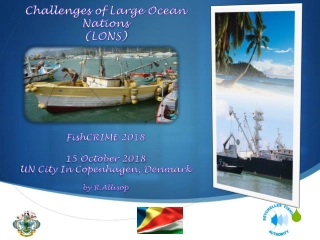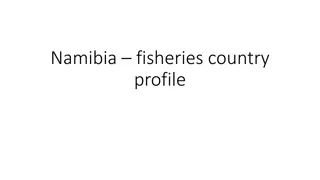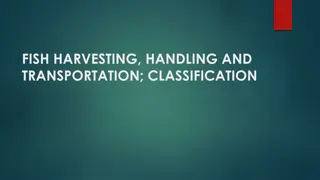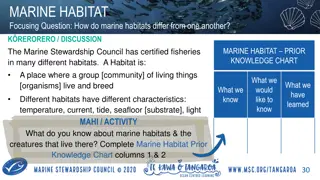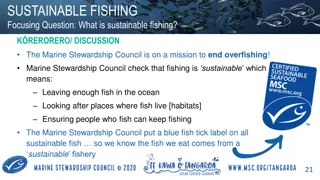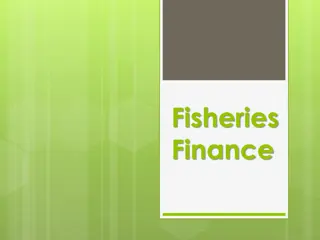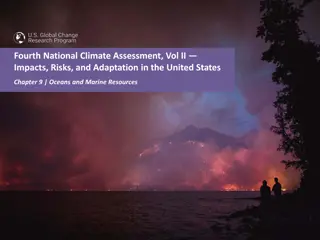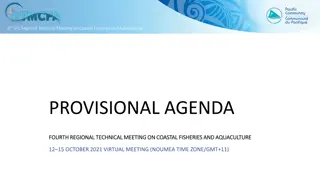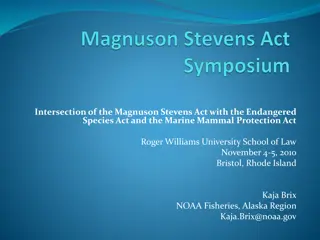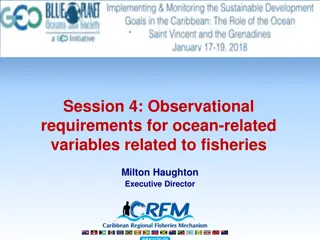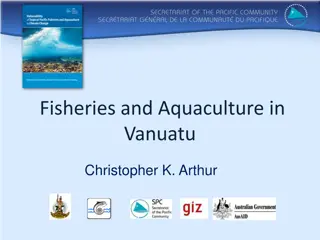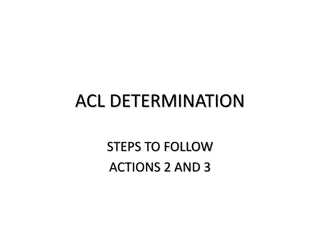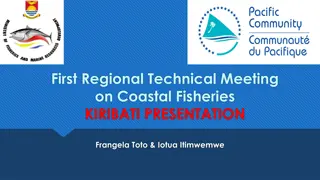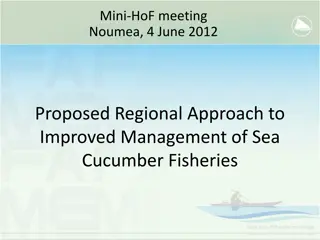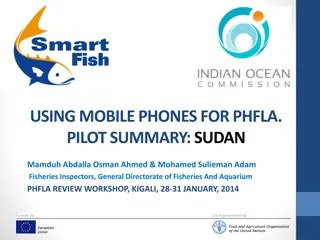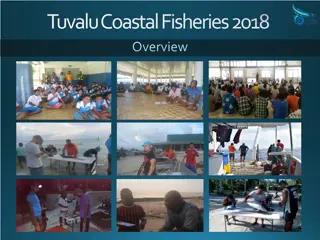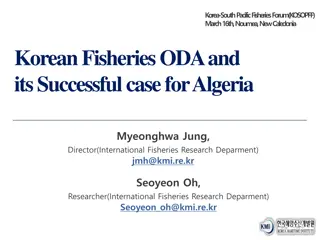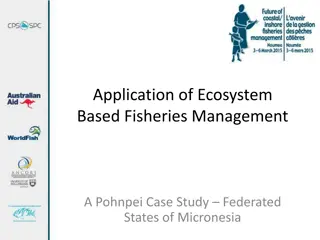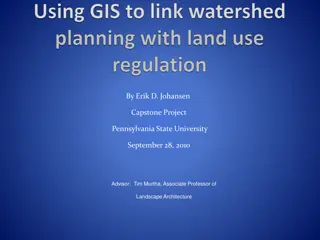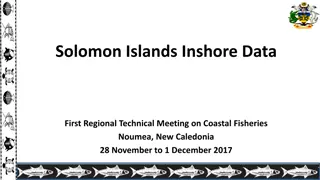Magnuson-Stevens Act: Ending Overfishing and Rebuilding Marine Fisheries
The Magnuson-Stevens Act aims to end overfishing and rebuild valuable marine fisheries in the US through sustainable practices such as catch shares and strong science. The act has a history of evolution, with the 2006 amendment mandating annual catch limits and market-based management. Councils play a crucial role in managing fisheries, developing Fishery Management Plans (FMPs) with measures like quotas and gear restrictions. Rebuilding US stocks could generate billions in revenue and support millions of jobs nationwide.
Download Presentation

Please find below an Image/Link to download the presentation.
The content on the website is provided AS IS for your information and personal use only. It may not be sold, licensed, or shared on other websites without obtaining consent from the author. Download presentation by click this link. If you encounter any issues during the download, it is possible that the publisher has removed the file from their server.
E N D
Presentation Transcript
Magnuson-Stevens Act Ending Overfishing and Rebuilding the Nation s Valuable Marine Fisheries Eric Schwaab Assistant Administrator September 8, 2024
Outline The Opportunity of Sustainable Fisheries Magnuson Act Overview The Regulatory Tool Box The Council Process Ending Overfishing and Rebuilding Catch Shares Strong Science Recreational Data Cooperative Research 2
Opportunity Opportunity Rebuilding US stocks would Increase the current ex-vessel value by an estimated $2.2 billion (54%) annually from $4.1 billion to $6.3 billion Generate an estimated additional $31 billion in sales nation-wide Generate $133 billion in sales and support 2 million jobs. 3
Magnuson Act History Magnuson Act History Pre Magnuson-Stevens Act (<1976) Open access, common property, foreign fleets 1976 Magnuson Act End foreign fishing, domestic fleet expansion, command and control management (quotas, effort, seasons, areas) 1996 Sustainable Fisheries Act Control expansion, limit current participation 2006 Magnuson-Stevens Act Reauthorization End overfishing, rebuild stocks, reduce overcapacity, catch shares Implementation is underway 5
The 2006 Amendment Magnuson-Stevens Fishery Conservation and Management Reauthorization Act of 2006 Signed on January 12, 2007 Mandates the use of annual catch limits and accountability measures to end overfishing Provides for widespread market-based fishery management through limited access privilege programs Calls for increased international cooperation Strengthens role of science in management 7
The Regulatory Toolbox Councils provide stakeholders a direct role in managing U.S. fisheries Councils develop FMPs and measures based on input by their SSCs, APs, plan teams, and public comment: Quotas, catch shares, bag limits Allocation between groups or sectors Seasonal or area closures Gear restrictions FMPs and management measures subject to approval by Commerce Secretary, acting through NOAA Fisheries 8
National Standard 1 Conservation and management measures shall prevent overfishing while achieving, on a continuing basis, the optimum yield from each fishery for the United States fishing industry. MSA Section 301(a)(1) 9
Ending Overfishing and Implementing Annual Catch Limits For a fishery that is subject to overfishing, Councils must: Develop and implement measures that end overfishing immediately Fishery management plans shall establish a mechanism for specifying annual catch limits at a level such that overfishing does not occur in the fishery, including measures to ensure accountability. Utilize the tools in the toolbox Annual Catch Limits set such that overfishing doesn t occur Accountability Measures to keep harvest on track May not exceed the Science and Statistical Committee s recommendation 10
Stocks Subject to Overfishing (40) as of September 30, 2010 New England: 1. Cod Gulf of Maine 2. Cod Georges Bank 3. Yellowtail flounder Southern New England/Middle Atlantic 4. 5. White Hake 6. Winter Flounder Georges Bank 7. Winter Flounder Southern New England/Middle Atlantic 8. Windowpane - Gulf of Maine / Georges Bank 9. Windowpane - Southern New England / Mid-Atlantic 10. Witch Flounder - Northwestern Atlantic Coast Yellowtail flounder Cape Cod/Gulf of Maine Highly Migratory Species: 1.Blue Marlin Atlantic2 2.White Marlin Atlantic2 3.Sailfish West Atlantic2 4.Albacore North Atlantic2 5.Bluefin Tuna West Atlantic2 6.Sandbar Shark 7.Dusky Shark 8.Blacknose Shark 9.Shortfin Mako - Atlantic Pacific: 1.Yellowfin Tuna Eastern Pacific2 Pacific and Western Pacific 1.Bigeye Tuna Pacific2 2.Pacific bluefin tuna Pacific2 South Atlantic: 1.Vermilion Snapper 3. Snowy Grouper 5. Red Grouper 7. Gag 9. Warsaw Grouper 2. Red Snapper 4. Tilefish 6. Black Sea Bass 8. Speckled Hind Gulf of Mexico: 1.Red Snapper 2.Greater Amberjack 3.Gag 4.Gray Triggerfish Caribbean: 1. Snapper Unit 1 2. Grouper Unit 1 3. Grouper Unit 4 4. Queen Conch 5.Parrotfishes1 1. Indicates non-FSSI stock 2. Stock is fished by U.S. and International fleets. U.S. Department of Commerce National Oceanic and Atmospheric Administration National Marine Fisheries Service Blue = Also Overfished Office of Sustainable Fisheries
Rebuilding Overfished Stocks For a fishery determined to be overfished, Councils must: Develop and implement measures within 2 years that begin rebuilding Set a rebuilding time that is as short as possible taking into account several factors does not exceed 10 years, except where biology, environmental conditions, or international agreements dictate otherwise 12
Overfished Stocks (47) as of September 30, 2010 New England: 1. Atlantic Cod Georges Bank 2. Yellowtail Flounder Georges Bank 3. Yellowtail Flounder Southern New England/Middle Atlantic 4. Yellowtail Flounder Cape Cod/Gulf of Maine 5. White Hake 6. Winter Flounder - Southern New England / Mid-Atlantic 7. Ocean Pout 8. Atlantic Halibut 9. Windowpane - Gulf of Maine / Georges Bank 10. Winter flounder - Georges Bank 11. Witch flounder - Northwestern Atlantic Coast 12. Smooth Skate 13. Atlantic Salmon1 14. Thorny Skate 15. Atlantic Wolffish - Gulf of Maine / Georges Bank1 North Pacific: 1.Blue King Crab Pribilof Islands Highly Migratory Species: 1.Blue Marlin Atlantic2 2.White Marlin Atlantic2 3.Albacore North Atlantic2 4.Bluefin Tuna West Atlantic2 5.Sandbar Shark 6.Porbeagle Shark 7.Dusky Shark 8.Blacknose Shark Pacific: 1. Cowcod 2. Yelloweye Rockfish 3. Canary rockfish - Pacific Coast 4. Petrale sole Pacific Coast 5. Coho salmon - Washington Coast: Queets1 6. Coho salmon - Washington Coast: Western Strait of Juan de Fuca1 7. Chinook salmon - California Central Valley: Sacramento (fall)1 Mid-Atlantic: 1.Butterfish (Atlantic) South Atlantic: 1.Pink Shrimp 2.Snowy Grouper 3.Black Sea Bass 4.Red Porgy 5.Red Snapper 6.Red Grouper Gulf of Mexico: 1.Red Snapper 2.Greater Amberjack 3.Gray Triggerfish 4.Gag Western Pacific September 8, 2024 1.Seamount Groundfish Complex Hancock Seamount Caribbean: 1.Grouper Unit 1 2.Grouper Unit 2 3.Grouper Unit 4 4.Queen Conch 1. Indicates non-FSSI stock 2. Stock is fished by U.S. and International fleets. U.S. Department of Commerce National Oceanic and Atmospheric Administration National Marine Fisheries Service 13 Office of Sustainable Fisheries
Measuring Progress 21 stocks rebuilt since 2000 The Fish Stock Sustainability Index measure increasing understanding of primary stocks and management success Fish Stock Sustainability Index (FSSI) 650 582.5 573 600 555.5 531 550 495.5506.5 Score 500 456 431.5 450 413.5 400 357.5369.5 350 300 2000 2001 2002 2003 2004 2005 2006 2007 2008 2009 Q3-10 Calendar Year 14
Catch Shares Catch share is a term used to describe fishery management programs that allocate a specific portion of the total allowable catch to individuals, cooperatives, communities, or other eligible entities. The recipient of a catch share is directly accountable to stop fishing when its exclusive share or allocation is reached. Catch Share Task Force 16
Final Catch Share Policy Statement To achieve long-term ecological and economic sustainability of the Nation s fishery resources and fishing communities: NOAA encourages the consideration and adoption of catch shares wherever appropriate in fishery management and ecosystem plans and amendments, and will support the design, implementation, and monitoring of catch share programs. 17
Northeast Groundfish Catch - 2010 All Sectors Common Pool Stock ACE/Quota (MT) Catch (MT) Percent Caught ACE/Quota (MT) Catch (MT) Percent Caught GB Cod GOM Cod American Plaice GB Winter Flounter GOM Winter Flounder Witch Flounder CC/GOM Yellowtail GB Yellowtail SNE Yellowtail GB Haddock GOM Haddock White Hake Pollock Redfish Total * 13 species and 20 stocks managed under the groundfish FMP **Catch includes Landings and Discards Source: NMFS Northeast Regional Office 3,302 4,327 2,748 1,823 133 827 729 803 235 40,186 799 2,505 16,178 6,756 81,352 982 1,647 3,458 1,639 11,503 29.7 38.1 20.9 46.9 15.8 29.8 12.6 43.8 5.2 8.6 12.9 25.3 10.1 13.1 14.1 128 240 100 29 25 25 50 20 75 254 26 51 375 90 1,488 12 213 29 9.6 88.6 28.8 30.0 84.8 116.4 55.4 92.0 2.0 36.2 20.4 77.8 21.1 6.3 39.1 575 855 21 247 92 352 12 9 21 29 28 18 2 92 5 40 79 6 582 103 633 887 Compiled October 28, 2010 18
Northeast Groundfish Sectors - Preliminary Results May 1 - September 30 Groundfish Landings Revenue State 2010 as a percent of 2009 (%) 102.4 2010 as a percent of 2009 (%) 129.5 2009 (MT) 2010 (MT) 2009 ($000) 2010 ($000) 2,094 1,368 8,990 13,663 2,144 7,213 11,080 3,713 2,589 19,688 1,977 1,152 29,119 4,807 1,870 21,115 1,904 1,148 30,844 ME NH MA RI Other NE 597 43.6 80.2 92.1 94.4 81.1 72.2 107.2 96.3 99.7 105.9 763 448 703 423 Total Landings in live weight Source: Northeast Regional Office Landings attributed to state based on principal port on permit application. Compiled October 28, 2010 19
Northeast Groundfish Sectors - Preliminary Common Pool Results May 1 - September 30 Groundfish Landings Revenue 2010 as a percent of 2009 (%) 2010 as a percent of 2009 (%) 132.6 State 2009 (MT) 2010 (MT) 2009 ($000) 2010 ($000) ME NH MA RI Other NE 121 60 282 112 32 223 14 116 498 93.2 52.8 79.2 162.1 229.1 95.3 202 144 710 23 129 1,208 268 117 820 46 288 1,539 81.6 115.5 195.4 223.3 127.4 9 51 522 Total Landings in live weight Source: Northeast Regional Office Landings attributed to state based on principal port on permit application. Compiled October 28, 2010 20
Science-based Decision-Making and Peer Review Peer review included in all stock assessments for federally managed stocks Functional science and statistical committees (SSC) in all councils Recommend science-based acceptable biological catches to the councils Provide information on scientific & management uncertainty to the councils Council/SSC control rules Risk assessment Likelihood catch will exceed the acceptable biological catch or ACL 21
Marine Recreational Information Program The Magnuson-Stevens Reauthorization Act called for more accurate and precise recreational fishing information Goals include: Improve the quality of catch and effort surveys. Create a national registry of saltwater anglers. Implement technical recommendations related to survey design and data collection. Improve the for-hire survey Evaluation of whether estimation procedures appropriately match sample designs www.CountMyFish.noaa.gov 22
Cooperative Research Involve commercial and recreational fishermen in the collection of information to support the development and evaluation of management options Benefits: Collection of more and better data at lower cost Improved access to vessels and time at sea Increase the precision and expand the scope of fisheries resource surveys Build mutual understanding and respect among participants 23
Questions? 24


